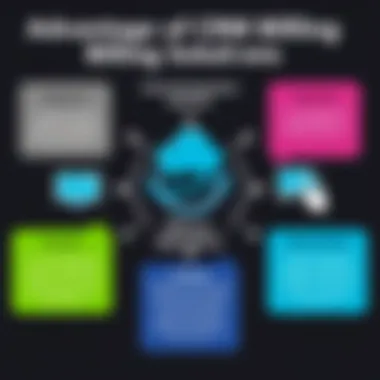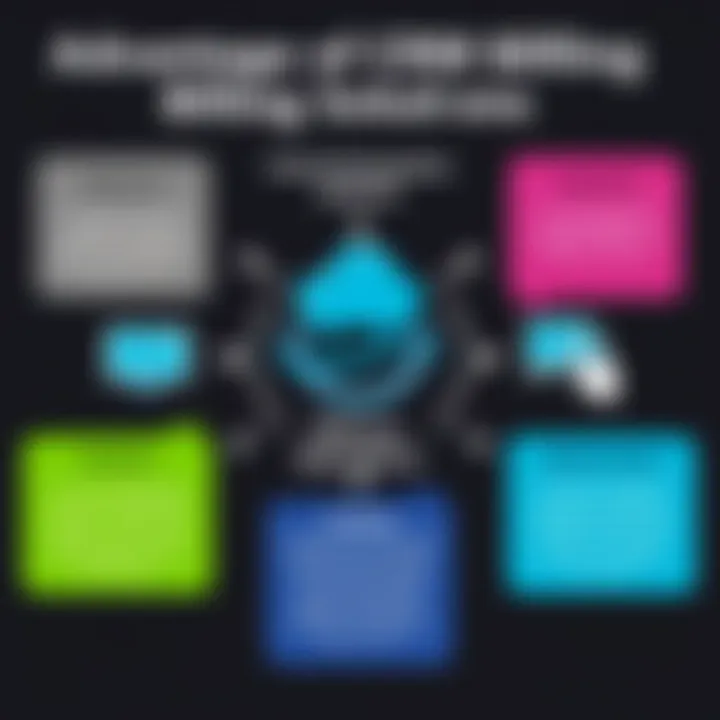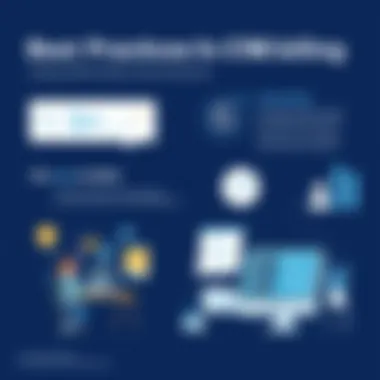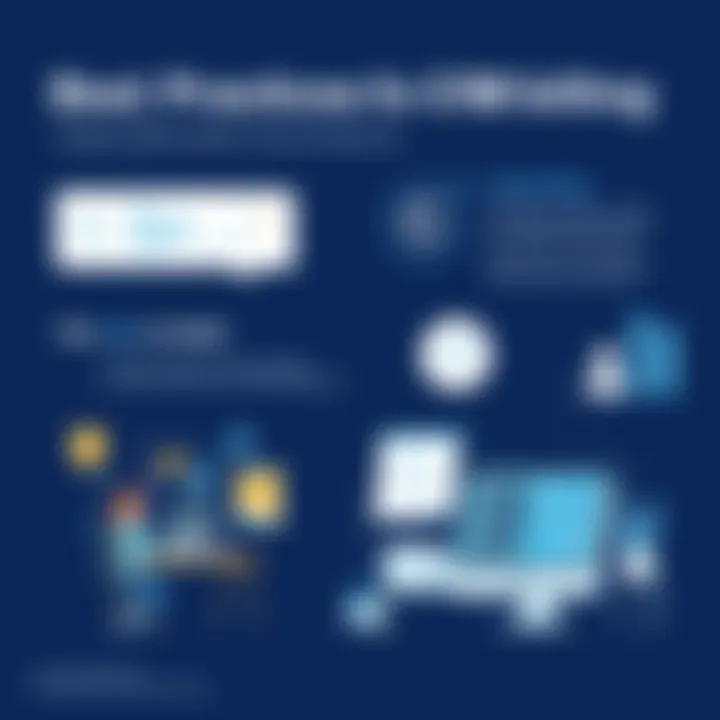Integrating CRM and Billing for Enhanced Operations


Intro
In today's fast-paced business environment, organizations are always on the lookout for ways to improve their operations and enhance customer experience. Customer Relationship Management (CRM) systems have become vital tools, integrating various functions to streamline processes. One of the most significant aspects that often gets overlooked is the billing process and how its integration within a CRM system can ultimately drive success.
Delving into CRM billing systems not only reveals the potential for financial optimization, but also sheds light on how these systems can influence customer satisfaction and loyalty. As we explore the features and benefits of these systems, we will highlight the importance of merging billing with CRM capabilities for improved operational efficiency.
The intricacies of modern business dealings necessitate a smooth interaction between sales, billing, and customer service departments. Traditional standalone billing systems may lead to discrepancies, causing frustration for both companies and customers. Integrating billing solutions into CRM platforms eradicates these issues, allowing teams to work with consistent, updated data at their fingertips.
Next, we will embark on a detailed exploration through the larger theme of CRM billing systems, discussing their increasing relevance, essential characteristics, and the challenges that businesses may face during implementation. The aim is to give organizations the insights they need to effectively harness these tools for their success.
Software Category Overview
Purpose and Importance
The purpose of CRM billing systems is clear: they’re designed to simplify the relationship between businesses and their customers by streamlining billing processes. Integrating billing into a CRM platform allows businesses to manage customer data, invoicing, and payments seamlessly. This integration results in enhanced accuracy in financial records and reduced data entry errors.
Why is this important? Well, studies demonstrate that companies with integrated systems can see up to a 30% increase in overall efficiency. This efficiency translates to quicker billing cycles and helps enhance overall cash flow—critical components for any thriving organization. With customers always pressing for faster, more transparent transactions, CRM billing systems can position a business ahead of the curve.
Current Trends in the Software Category
As we look at trends shaping the CRM billing landscape, a few standout patterns emerge:
- Cloud-Based Solutions: More businesses are moving to cloud computing for flexibility, accessibility, and scalability. Software like Salesforce and Zoho have made significant strides in providing robust CRM billing solutions in the cloud.
- Automation: Automating billing processes not only minimizes errors but enhances speed. Features like recurring billing and automated invoice generation are gaining traction.
- Data Analytics: Companies are increasingly utilizing data analytics to gain insights from their billing and customer interactions. This data can inform pricing strategies and identify upselling opportunities.
Understanding these trends is vital for businesses, as it helps them stay relevant and competitive in a continuously evolving market.
Data-Driven Analysis
Metrics and Criteria for Evaluation
When evaluating CRM billing systems, it is essential to look at specific metrics and criteria to understand their true effectiveness:
- System Integration: How well does the software integrate with existing tools and platforms?
- User Experience: A user-friendly interface that simplifies the billing process can significantly affect user adoption.
- Cost-Effectiveness: Evaluate both the upfront and ongoing costs associated with the software, considering factors like scalability.
- Support and Updates: Assess the level of customer support provided and the frequency of software updates, which is crucial for addressing emerging issues.
These evaluation criteria help demystify the multitude of options available and guide businesses in choosing the right solution for their needs.
Comparative Data on Leading Software Solutions
A comparative analysis of popular CRM billing systems can yield important insights. Here’s a brief overview of notable solutions:
- Salesforce: Known for its extensive features and a robust integration ecosystem, Salesforce dominates the market with its flexibility and customizability.
- Zoho CRM: This solution is popular among small to medium-sized businesses because of its affordability and ease of use. It integrates billing functionalities without overwhelming users.
- FreshBooks: Tailored for service-based businesses, FreshBooks focuses heavily on invoicing and expense tracking, providing a straightforward interface.
Each of these solutions has its unique strengths and weaknesses, and the right choice usually hinges on specific business requirements and budget.
By examining the current trends and key metrics, businesses can make informed choices about which CRM billing systems to implement, leading to better management of financial operations and improved customer relationships.
Understanding CRM Systems
Customer Relationship Management (CRM) systems have emerged as indispensable tools in modern business environments. They offer a framework for managing relationships with customers, potential clients, and partners through technology. Understanding these systems is crucial as they drive significant efficiencies in customer interactions, sales processes, and marketing strategies. For businesses looking to improve customer satisfaction and streamline operations, delving into the intricacies of CRM systems forms the bedrock for effective billing integration, ultimately leading to better financial management and improved operational efficacy.
Definition and Purpose
In its simplest form, a CRM system can be defined as a technology that helps in managing all aspects of company interactions with current and potential customers. The core purpose is to streamline processes, increase profitability, and enhance customer service. These systems compile data from various channels, including a company’s website, telephone, email, and social media. This centralized data collection allows businesses to maintain detailed records about customer interactions, preferences, and behaviors.
The main purpose of CRM systems can be summarized as follows:
- Improved Customer Insights: By compiling historical data, businesses can better understand their customers' needs and preferences, leading to more tailored solutions.
- Enhanced Communication: CRM systems facilitate smoother communication between sales teams and customers, minimizing friction and keeping both parties aligned on expectations.
- Efficiency in Operations: By automating routine tasks, teams can focus on higher value activities, saving time and resources.
Key Features of CRM Systems
A well-designed CRM platform is packed with features designed to support various facets of business operations. Here are some of the notable ones:
- Contact Management: This core feature allows businesses to store and manage customer information in one place, making it easy to track every interaction.
- Lead Management: Efficiently manage prospective clients, tracking how leads are generated and ranked based on their likelihood of conversion.
- Task Automation: Many CRM systems include tools to automate routine tasks, such as sending email reminders or scheduling follow-ups, which enhances productivity.
- Reporting and Analytics: These features provide insights into customer behavior, allowing businesses to make data-driven decisions that can enhance marketing and sales strategies.
Incorporating these features can dramatically enhance CRM effectiveness.
Importance of CRM in Business


CRM systems are not just about cold data; they serve as the foundation upon which strong customer relationships are built. Understanding their importance is paramount for any business aiming for long-term growth and success. Consider the following points:
- Customer Retention: Satisfied customers are more likely to repurchase and become brand advocates. CRM systems help businesses keep track of customer satisfaction metrics, which can inform retention strategies.
- Sales Growth: With accurate information and streamlined processes, businesses can identify upsell or cross-sell opportunities, thus enhancing revenue.
- Market Trend Analysis: CRM systems assist businesses in identifying emerging trends within their customer base, allowing them to adapt quickly and remain competitive.
A well-implemented CRM can mean the difference between a thriving business and one that flounders due to miscommunication and inefficiencies.
By understanding CRM systems comprehensively, businesses can pave the way for integrated billing systems that will further refine their operational prowess and financial dealings.
Integrating Billing into CRM
Integrating billing processes directly into Customer Relationship Management (CRM) systems fundamentally transforms the way businesses manage their financial operations. This integration serves as a bridge connecting sales, marketing, and financial functionalities, enhancing the overall efficiency of operations. The synergistic relationship offers several noteworthy benefits, including streamlined workflows, improved data accuracy, and a superior customer experience.
The significance of this integration cannot be overstated — as customer demands shift in today’s fast-paced environment, organizations that fuse technological capabilities with customer interactions are set to flourish. For instance, automating billing allows sales teams to quickly generate invoices based on sales data, significantly reducing manual errors. In addition, having all customer and billing information in one place minimizes the chances of miscommunication between departments, enhancing collaboration.
The Rationale for Integration
The rationale for integrating billing within CRM systems is rooted in the desire to optimize business operations. Here are some key elements that illustrate why this integration is beneficial:
- Centralized Data Management: With billing information residing in the CRM, there's no need to toggle between multiple systems. This means that both customer service representatives and accountants can access the same data, leading to fewer discrepancies and improved communication.
- Seamless Customer Interaction: Integrating billing keeps customer interactions fluid. For example, if a customer inquires about a charge on their account, the service rep can provide immediate feedback because they can view transactions in real time.
- Enhanced Reporting Capabilities: Businesses can automate reporting by leveraging analytics within the CRM. By analyzing combined sales and financial data, firms can better understand customer purchasing behaviors and patterns, leading to informed decision-making.
- Cost Reduction: Reducing manual processes not only speeds up operations but also cuts costs. Staff can focus on strategic initiatives rather than being tied down with repetitive tasks.
Overall, integrating billing into CRM systems makes perfect sense in a world where efficiency and customer satisfaction reign supreme. It paves the way for businesses to not just keep pace with competitors but to lead the charge toward excellence.
How Billing Functions Enhance CRM
The integration of billing functions into CRM systems enhances various aspects of customer relationship management. This is how the transform occurs:
- Improved Accuracy: Automated billing minimizes human error, ensuring that invoices reflect the correct amounts and thus fostering trust with customer relationships.
- Streamlined Processes: Through automation, the linking of sales data to billing processes speeds up the invoicing cycle. The faster a business can bill clients, the quicker they can collect payments, improving cash flow substantially.
- Personalized Customer Experience: With billing info linked to CRM, sales and service teams can create tailored offers based on the customer's purchase history and preferences. This customization not only delights customers but can also lead to increased sales.
- Real-time Financial Insights: Billing functions deliver immediate insights into a company’s revenue streams. This real-time perspective allows businesses to react promptly to shifting market demands, ensuring they remain agile in a competitive landscape.
Integrating billing functions streamlines tasks and ensures accuracy, paving the way for enhanced revenues and customer satisfaction.
Core Features of CRM Billing Systems
Understanding the core features of CRM billing systems is pivotal for organizations looking to enhance their financial management and customer interactions. These systems not only automate tedious processes but also ensure accuracy and integration with existing business workflows. The features discussed in this section illustrate how CRM billing systems can serve as a backbone for financial operations while improving customer satisfaction and operational efficiency.
Automated Invoicing Mechanisms
When it comes to the heart of financial transactions, automated invoicing stands out as a critical feature of CRM billing systems. Essentially, this mechanism allows businesses to generate invoices without manual input, saving a good chunk of time and reducing errors that often arise from manual billing processes.
For example, consider a software company offering subscription-based services. With an automated invoicing system, they can set specific billing cycles at the start of the service, and the CRM will handle subsequent invoices automatically. This not only simplifies the billing process for the company but also ensures that customers receive timely and accurate invoices. Moreover, automated invoicing can help in maintaining consistent cash flow, an essential factor for any business’s financial health.
Furthermore, companies can tailor invoice templates to align with their branding. Customization options allow businesses to include relevant details as well as promotional messages, thus enhancing brand visibility while keeping financial transactions straightforward.
Payment Processing Integrations
Integrating with various payment processing platforms is another crucial feature of CRM billing systems. This capability allows businesses to accept a myriad of payment methods—from traditional credit cards to newer digital wallets—without the hassle of managing multiple systems.
A real-world example can be seen in e-commerce businesses that store customer payment information securely within their CRM. When repeat customers opt to purchase again, the systems can facilitate transactions seamlessly, further enhancing the user experience. Integration with platforms like PayPal or Stripe lets businesses offer their customers convenient payment options while ensuring safety and compliance with regulations.
Additionally, such integrations provide real-time updates regarding transaction statuses, which enables organizations to track payments effortlessly. This can minimize discrepancies and provides clarity not only for the business but for customers who want to know their transaction history at a glance.
Tracking and Reporting Financial Data
An often-overlooked aspect of billing systems is their ability to track and report financial data. This capability enables companies to compile comprehensive reports that are vital for informed decision-making. In an era where data-driven insights can make or break a business, the tracking feature proves to be indispensable.
Organizations can generate reports that reveal trends in customer payments, outstanding invoices, and revenue forecasts. For instance, a consulting firm could track billable hours alongside payments received, allowing them to analyze which clients generate the most revenue. Moreover, visual representations such as charts and graphs can aid in quick assessments of financial health and performance.
Inadequate financial tracking may lead to revenue leaks and dissatisfied customers. Having precise metrics empowers businesses to make proactive decisions that align with customer expectations and financial goals.
Benefits of CRM Billing Systems
Integrating billing systems within Customer Relationship Management (CRM) software yields valuable benefits for businesses across various sectors. The advantages range from enhanced accuracy of financial data to improved customer satisfaction. These elements can redefine workflows and offer operational efficiencies. Understanding these benefits can help organizations make informed decisions about implementing effective CRM billing approaches.
Enhanced Accuracy and Consistency
One of the primary benefits of CRM billing systems is the significantly improved accuracy and consistency of financial data. Traditional billing methods often involve multiple manual inputs which inherently introduce risk for errors. Inaccurate billing can lead to substantial issues, from customer dissatisfaction over erroneous charges to misplaced revenue forecasts. CRM billing systems centralize this information, reducing the need for repetitive entry and thus lowering the chances for inconsistency.
Moreover, these systems regularly sync with data sources. This gives real-time insights into billing information and ensures that all stakeholders are operating from the same current data. For instance, if a customer changes their subscription plan, the adjustment is reflected immediately in all financial documents. This fluidity cultivates trust with customers who receive accurate invoices and consistent service.
"Accurate billing is not just a nice-to-have; it’s a need-to-have in fostering strong customer relationships."


Time Efficiency and Resource Management
Time is money, as the saying goes, and CRM billing systems give businesses a way to harness that time effectively. By automating many of the tedious billing tasks, these systems liberate staff from spending precious hours on administrative duties, allowing that time to be redirected towards strategic initiatives.
For example, automated invoicing reduces the time spent manually creating, sending, and tracking invoices. The financial team can instead focus on analyzing trends, addressing complex customer queries, and devising strategies to promote customer retention. Additionally, CRM billing facilitates better resource management; businesses can allocate their team’s talents based on their skills rather than on mundane tasks that can be automated.
Furthermore, integration with other business processes, such as project management and customer service, creates a flow of information that optimizes overall operations. By employing these systems, companies streamline processes and allow for a more strategic allocation of resources. Businesses not only save time but also reduce operational costs over time.
Improved Customer Experience and Satisfaction
In today’s fast-paced market, delivering exceptional customer service is imperative, and CRM billing systems play a crucial role in achieving that. Timely and accurate billing enhances the overall customer experience, which in turn fosters loyalty and retention. When customers receive their invoices without discrepancies, they can proceed with their payments without frustration.
Moreover, the transparency of these systems allows customers to easily access their billing history, subscription details, and payment statuses. This self-service capability helps customers feel empowered and informed about their transactions, ultimately increasing satisfaction. For instance, clients can quickly manage their subscriptions or inquire about charges with ease, leading to quicker resolutions and less back-and-forth communications.
Additionally, seamless integration with customer support channels ensures that if customers do have questions or issues regarding their invoices, they are addressed promptly, further enhancing their overall experience. The result? Happy customers who are more likely to return for business and recommend the service to others.
Challenges of Implementing CRM Billing
Integrating billing into a Customer Relationship Management (CRM) system may seem like a straightforward task at first glance. However, the implementation of CRM billing presents several challenges that businesses must navigate. Recognizing these obstacles is crucial for any organization aiming to effectively streamline financial operations. This section dives into three prevalent challenges: technical integration issues, user training and adoption hurdles, and cost considerations.
Technical Integration Issues
Technical integration stands as one of the most formidable challenges when implementing CRM billing systems. The success of any integration hinges on how well the chosen CRM platform interacts with existing financial software and databases. Mixing old and new technologies can sometimes be like fitting a square peg into a round hole. Here are some key concerns that can arise:
- Data Migration: Transferring historical financial data into a new system can be daunting. If the data is not clean or formatted correctly, this migration process can lead to inconsistencies and errors in billing.
- Compatibility: Not all software is created equal. Differences in platforms can lead to significant compatibility issues, potentially delaying the rollout.
- System Downtime: The integration process can take time. In an industry that thrives on efficiency, any extended downtime can result in lost revenue and frustrated customers.
Tackling these technical hurdles requires careful planning and possibly the involvement of specialized IT consultants. Businesses must ensure that the technical aspects are well handled to prevent complications down the line.
User Training and Adoption Hurdles
Even with a robust CRM billing system in place, if users struggle to understand it, the benefits can be completely lost. User training often becomes one of the significant stumbling blocks. Here’s why this is crucial:
- Resistance to Change: Often, employees become accustomed to existing systems. Switching to a new platform might bring about pushback, as individuals may feel they are being forced to learn something new.
- Learning Curve: Some CRM billing systems are complex, and employees might require comprehensive training for effective utilization. This might divert time from their regular duties, possibly impacting productivity.
- Ongoing Support: After the initial training, continuous support is essential. Staff may face new issues as they begin using the system, and without timely support, this can frustrate users and hamper productivity.
To overcome these hurdles, organizations can focus on creating a clear training program that encourages employees to engage with the new system. Utilizing success stories of teams who have benefitted from the system can also incentivize reluctant users.
Cost Considerations for Businesses
Implementing a CRM billing system undeniably comes with a price tag. Companies must weigh these costs against the potential benefits. Some key points to consider include:
- Upfront Costs: These include expenses like software licensing fees, consultant fees, and initial training costs. They can pile up quickly, leading to budget challenges.
- Maintenance and Upgrades: Post-implementation, ongoing costs may arise from software updates, customer support, and further training.
- ROI Assessment: Organizations should measure the return on investment carefully. If the expected financial benefits do not outweigh the costs, the implementation can be viewed as unsuccessful.
Businesses should adopt a strategic approach to budgeting for CRM billing systems, considering all the factors involved and estimating potential savings on operational tasks.
It is essential for companies to view the integration of CRM billing not just as an expense but as an investment towards better financial efficiency and improved customer relations.
In summary, while there are challenges to implementing CRM billing systems, recognizing and strategizing around these issues can lead to a seamless transition. With careful consideration of technical integration, thorough user training, and prudent financial planning, organizations can enhance their CRM billing systems and ultimately improve their operations.
Best Practices for CRM Billing Implementation
Implementing CRM billing systems involves careful consideration to reap the full benefits these tools offer. Proper execution of best practices can mitigate challenges while enhancing business operations. These strategies ensure that the integration aligns with the company’s objectives and customer needs.
Choosing the Right CRM Platform
Selecting an appropriate CRM platform is paramount. This involves analyzing features that best suit your business's requirements. Not all CRM systems are created equal, and the right choice will depend on factors such as scalability, integration capabilities, and user-friendliness.
- Understand Your Needs: Assess the unique needs of your business. Are you a small startup or a large corporation? Each has distinct requirements that should guide your choice.
- Research Compatibility: Look for platforms that seamlessly integrate with existing tools like QuickBooks or PayPal. Compatibility minimizes disruptions and helps in smoother transitions.
- Trial Versions: It can be beneficial to utilize trial versions of potential CRM solutions to test their functionality before making a financial commitment.
- Feedback Loop: Engaging with peers or communities, such as forums on Reddit, can provide insights on popular platforms and their real-world applications.
Customizing Billing Processes
The next step is to tailor the billing processes within your chosen CRM. A one-size-fits-all approach rarely yields optimum results. Customization ensures that the system fits the specific workflows and operational needs of your organization.
- Define Workflows: Establish clear workflows that align with how your business operates. This might involve modifying invoicing templates or setting up reminders for outstanding payments.
- Automate Tasks: Automation of routine processes minimizes manual errors. Implement features like automated payment reminders or recurring billing options. This can not only save time, but it also improves cash flow management.
- Solicit User Input: Develop the system with feedback from your team members. They will be the end users, and their insights can help in maximizing the tool’s efficiency.
Monitoring and Evaluating Performance
Once the CRM billing system is in place, it’s essential to continuously monitor and assess its effectiveness. Regular evaluations will highlight areas of improvement and ensure that the system remains aligned with business goals.
- Use Analytics: Many CRM platforms offer analytics dashboards. These tools can help track critical metrics like invoice conversion rates and payment timelines.
- Regular Feedback Sessions: Hold periodic feedback sessions with users to discuss what’s working and what’s not. This keeps the system dynamic and responsive to changing needs.
- Benchmarking: Compare your billing performance against industry standards. This can shed light on how well your system is functioning and where adjustments might be necessary.


"A good CRM billing system is not just a tool; it’s the backbone of a well-oiled financial operation."
Evaluating Popular CRM Billing Solutions
The evaluation of CRM billing solutions stands at the forefront of a business's efforts to streamline operations. As organizations increasingly depend on technology to manage customer interactions and financial transactions, choosing the right platforms becomes paramount. Not every solution is a perfect fit for every business. Therefore, understanding how to critically assess these tools is crucial.
Comparison of Leading Platforms
When delving into various CRM billing options, it's essential to make informed comparisons. Each platform has unique strengths and weaknesses that can greatly affect operational efficiency. For instance, Salesforce provides remarkable customization capabilities, allowing businesses to tailor the platform to meet specific needs. In contrast, HubSpot focuses on user experience, offering a more straightforward interface for those less tech-savvy. A few factors to consider in the comparison process include:
- Functionality: Does the software cover all necessary billing tasks? Lookout for things like invoicing, payment processing, and integration with other systems.
- User Interface: A complex interface can deter staff from using the system effectively. Sometimes, less robust systems with a user-friendly design can be more beneficial.
- Customization Options: As businesses evolve, so too do their requirements. Strong platforms often allow for greater flexibility and customization.
Evaluating these features through trials or demos can give businesses a hands-on understanding of what works best for them, ensuring the chosen CRM billing system aligns with existing processes.
User Reviews and Feedback
Customer reviews and feedback represent a wealth of insights. Engaging with user experiences can shine a light on the hidden benefits or pitfalls of various CRM billing solutions. Review platforms such as G2 or Capterra can provide honest, unaffiliated opinions that might reveal aspects of software capabilities not covered during demos. Key takeaways often highlighted in user feedback include:
- Reliability: Does the system function consistently, without frequent errors?
- Support: Do users feel adequately supported by the vendor? Prompt and effective customer service is a huge plus.
- Overall Satisfaction: Do users recommend the platform? High levels of recommendation can indicate a dependable product.
Investing time in understanding peer experiences can often preempt many issues that might surface later.
Pricing Structures of CRM Solutions
Price remains a key aspect in choosing a CRM billing solution. Each platform offers varying pricing structures which can significantly impact a business’s budget. It's vital to comprehend what each package includes, as well as what expenses might emerge later on. Here are some considerations:
- Subscription vs. One-Time Fee: Some systems may offer a one-time purchase model, while others follow a subscription service, which might affect cash flow and budgeting.
- Hidden Costs: Be wary of additional fees that can arise, such as those for integrations, additional features, or training. Clarifying these costs upfront is critical in evaluating the total expense of the system.
- Tiered Plans: Many platforms offer several tiers of service, ranging from basic to premium. Identifying which plan fits your requirements is essential in ensuring you don't pay for unnecessary features.
This evaluation stage is not just about calculating expenses but about assessing how each solution meets both current and projected business needs.
Effective evaluation of CRM billing solutions can help businesses realize streamlined processes, ultimately leading to increased productivity and enhanced customer relationships.
Future Trends in CRM Billing
As businesses evolve and customer expectations shift, the role of CRM billing systems is set to change significantly. Understanding these future trends is pivotal for companies looking to maintain a competitive edge in an increasingly digital economy. Exploring trends in CRM billing can uncover transformative practices, allowing organizations to enhance efficiency, improve customer interactions, and leverage cutting-edge technology to shape financial operations.
AI and Machine Learning Integration
Artificial Intelligence (AI) and machine learning are becoming integral components of CRM billing systems. These technologies enable systems to analyze vast amounts of data generated during billing cycles. With precise algorithms, the systems can identify patterns that may go unnoticed by human analysts. For instance, machine learning can predict which customers are likely to be late payers based on factors such as payment history and previous interactions. This proactive approach not only helps in optimizing cash flow but also streamlines the collection process, allowing organizations to address potential issues before they escalate.
Furthermore, AI can automate mundane billing tasks, such as invoice generation and payment reminders. By reducing manual intervention, businesses can allocate resources more effectively and concentrate on strategic initiatives. The deployment of chatbots powered by AI can also enhance customer service. Customers can get instant responses to their inquiries about billing, which leads to a more seamless and satisfactory experience.
Mobile Payment Innovations
The rise of mobile payment options has transformed how consumers interact with billing processes. More and more customers favor the convenience of transactions via smartphones. Recognizing this trend, businesses are incorporating mobile payment integration into their CRM billing systems. This integration not only provides customers with various payment options but also enhances overall user experience.
For example, solutions like Apple Pay and Google Wallet allow for quick and secure transactions right from mobile devices. This ease of payment can lead to faster payment cycles and improved cash flow for businesses. Additionally, mobile payment innovations facilitate easier tracking of transactions and receipts, making reconciliation processes more efficient. Companies that adapt to these mobile-centric trends stand to gain a competitive advantage, as they cater to the preferences of a tech-savvy clientele.
Enhanced Analytics and Insights
The future of CRM billing systems will increasingly focus on enhanced analytics capabilities. As data grows exponentially, the ability to mine useful insights from this data becomes crucial. Advanced analytics will help businesses not only monitor billing metrics but also uncover trends that inform business strategies. For instance, data visualization tools integrated into CRM platforms can present financial information in comprehensible formats, enabling decision-makers to act swiftly based on real-time data.
Moreover, predictive analytics can forecast future revenue and identify potential risks in billing processes. This foresight allows companies to make informed decisions, enhancing both performance and customer relationships. By accessing deeper insights into customer behavior, businesses can tailor their services and offers to meet specific needs, leading to improved customer loyalty and retention.
With the integration of AI, mobile payment innovations, and enhanced analytics, CRM billing systems are set to play a pivotal role in reshaping how businesses interact with their customers financially.
As we look to the future, the fusion of these trends promises to create a more dynamic and responsive CRM billing landscape, making it a focal point of ongoing business innovation.
Businesses must keep their finger on the pulse of these trends and adapt their CRM billing strategies accordingly to thrive in an ever-changing market.
End
In the world of business, every operation counts, and this holds especially true for the intersection of Customer Relationship Management (CRM) systems and billing processes. Understanding how these components work together not only lays the groundwork for streamlined financial practices but also fosters a profound enhancement in customer satisfaction. By integrating billing into CRM platforms, companies can ensure a more seamless flow of information, which directly impacts decision-making and operational efficiency.
Summarizing Key Insights
As we've delved into this topic, several key points come to light:
- Integration Benefits: Integrating billing processes within CRM systems enhances data accuracy, minimizes manual errors, and promotes timely financial transactions. This leads to a clearer financial picture for businesses, enabling better planning and forecasting.
- Customer Satisfaction: A robust CRM billing system not only automates invoicing but also tracks payments and manages customer queries seamlessly, improving the overall customer experience. Happy customers are likely to stick around, contributing to customer retention rates — a crucial factor in long-term success.
- Implementation is Key: While the benefits are significant, successful implementation of CRM billing systems requires careful planning. Understanding the different platforms and customizing the functionalities to fit the specific needs of your business can make all the difference.
- Future Trends: As technology evolves, so too do CRM billing systems. Innovations in AI, machine learning, and mobile payment options are paving the way for smarter, more efficient billing solutions that can adapt to changing market demands.
Final Thoughts on CRM Billing
Ultimately, CRM billing systems represent a confluence of efficiency and effectiveness in business management. For organizations looking to enhance their operations, investing in a CRM billing solution is more than just adopting a new tool; it’s about embedding a culture of accuracy, transparency, and customer-centricity into the fabric of the company. Only by navigating the unique challenges and leveraging the strengths of these systems can companies hope to thrive in a market that is ever-evolving.
Companies that embrace the integration of CRM and billing processes today will likely set themselves apart tomorrow, paving the way for not only sustainable growth but also a solidified relationship with their customers. Let’s remember, in business, it’s often the details that make the difference.







